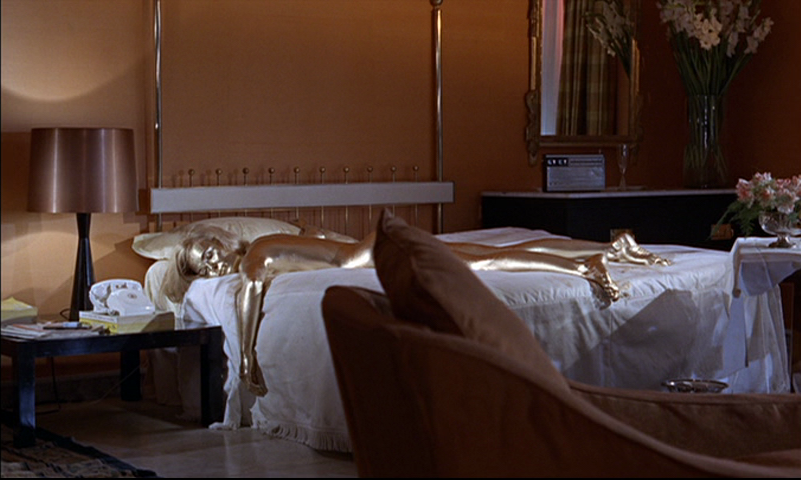Jake’s Take: One Image from Goldfinger (Guy Hamilton, 1964)
The image of a girl painted in gold, in the film some consider the gold standard for the James Bond series.
“Gold? All over?”
In my previous posts on Dr. No and From Russia with Love, I have mentioned espionage and escapism. Perhaps the most famous film in the series, Goldfinger brings a third “e” word into the mix: excess.
It’s not just that stunning theme song by Shirley Bassey, which runs circles around Matt Munro’s theme for FRWL and remains an easy choice for greatest Bond theme. It’s not that Bond is put up in the best hotel in Miami Beach toward the beginning. (Though I question that, since no one calls him on that blue terrycloth onesie he’s, um, sporting?) It’s not just that he soon thereafter has a beautiful woman in one hand and a bottle of Dom Perignon ’53 in the other.
It’s that gold paint is used as a murder weapon.
The image above is at once revolting and captivating. It is most certainly excessive. And like many others in the film, it is an image that remains indelibly imprinted on your memory. The image of the golden girl (Shirley Eaton in the film, and Margaret Nolan in the titles and the ads) became an iconic one for the series. Without going down too Freudian a road, this moment also marks a shift in the films that is decades later aptly characterized by Miranda Frost (Rosamund Pike) in Die Another Day: “sex for dinner, death for breakfast.” In one sense, this scene provides some fidelity to Ian Fleming’s novel, in which Jill Masterson (Eaton) meets the same fate, more or less. It’s indicative of some of the more elaborate sadism that Fleming injects into his prose, and though certainly in a less explicit way, it’s something the films will ramp up as time goes on (e.g. Casino Royale riffing on the concept of elaborate tortures, thanks to the perfect terror of Mads Mikkelsen and the “balls-and-a-rope” sequence).
In another sense, the scene serves to turn Jill into what Raymond Benson (The James Bond Companion) dubbed the OSL: the obligatory sacrificial lamb. Like Quarrel and Kerim Bey before her, she is killed for aiding Bond in his mission. The murder shows us Auric Goldfinger’s mania for gold, and his mercilessness toward anyone who would interfere with his plans. It also provides some personal stakes for Bond to go after Goldfinger (played by the iconic Gert Frobe), who is initially presented in a rather understated way as a card-cheat. To be sure, personal stakes are nothing extraordinary when discussing serial heroic fiction, but when Bond discusses Jill’s death with M, Connery gives us a taste of what is to come from George Lazenby and most especially Timothy Dalton and Daniel Craig when 007 shifts from mission to personal vendetta.
As for my thoughts on the film itself, and in keeping with the excess theme, Goldfinger is the one film I have actually posted on previously here at the MFF. (Two posts for the price of one, good reader!) In short, it is, if not a great film, certainly a grand one. It is also a bizarre one, as Rob Thomas recently discussed in this excellent post. Of the four films Guy Hamilton directed, it is inarguably his best entry in the series—a non-controversial claim if ever there was one. His films inject more silliness into the proceedings, and Goldfinger is the only one where that silliness doesn’t overwhelm the rest of the movie. It also plays with heist conventions in a very satisfying fashion (“You want to break into the world’s largest bank, but not to steal anything…”). One other quick point: as I state in my previous post on this film, the pre-titles sequence is a truly great one, but people will often point to its lack of connection to the main plot as a formulaic aspect of the series. This is simply incorrect, as most of the pre-titles sequences have direct impact on the plot. They are great sequences in their own right, but they are—with few exceptions—far from disconnected from the overarching story.
All other achievements and shortcomings notwithstanding, though, Goldfinger is really the point where the Bond franchise turned from powerful force to unstoppable juggernaut, with many future entries becoming about outdoing their predecessors with the ever more outlandish, the ever more glamorous, and the ever more excessive.
Rankings
5. From Russia with Love
9. Goldfinger
10. Dr. No
